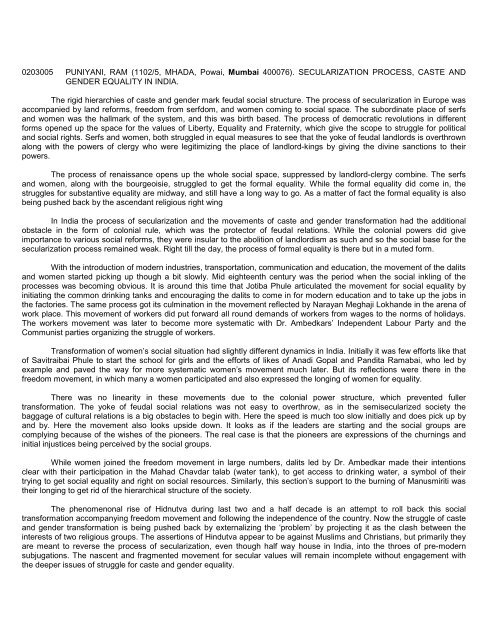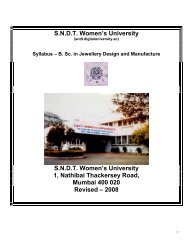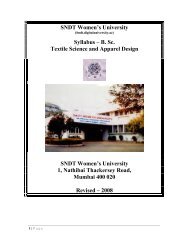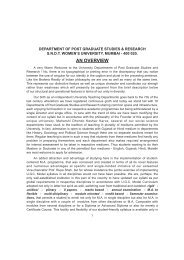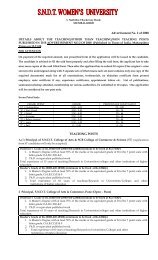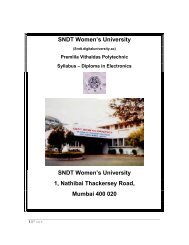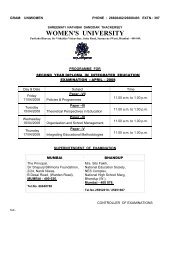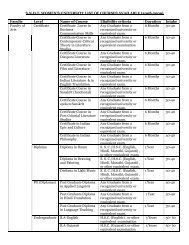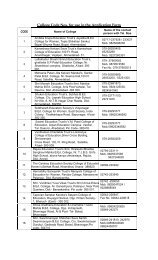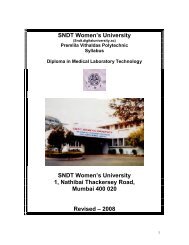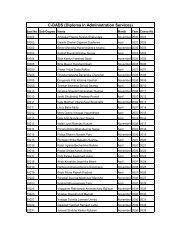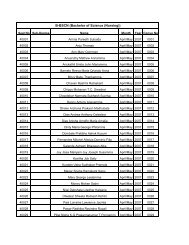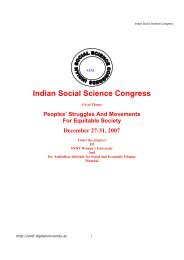XXXI Abstracts Part 1 page 1-189
XXXI Abstracts Part 1 page 1-189
XXXI Abstracts Part 1 page 1-189
Create successful ePaper yourself
Turn your PDF publications into a flip-book with our unique Google optimized e-Paper software.
0203005 PUNIYANI, RAM (1102/5, MHADA, Powai, Mumbai 400076). SECULARIZATION PROCESS, CASTE AND<br />
GENDER EQUALITY IN INDIA.<br />
The rigid hierarchies of caste and gender mark feudal social structure. The process of secularization in Europe was<br />
accompanied by land reforms, freedom from serfdom, and women coming to social space. The subordinate place of serfs<br />
and women was the hallmark of the system, and this was birth based. The process of democratic revolutions in different<br />
forms opened up the space for the values of Liberty, Equality and Fraternity, which give the scope to struggle for political<br />
and social rights. Serfs and women, both struggled in equal measures to see that the yoke of feudal landlords is overthrown<br />
along with the powers of clergy who were legitimizing the place of landlord-kings by giving the divine sanctions to their<br />
powers.<br />
The process of renaissance opens up the whole social space, suppressed by landlord-clergy combine. The serfs<br />
and women, along with the bourgeoisie, struggled to get the formal equality. While the formal equality did come in, the<br />
struggles for substantive equality are midway, and still have a long way to go. As a matter of fact the formal equality is also<br />
being pushed back by the ascendant religious right wing<br />
In India the process of secularization and the movements of caste and gender transformation had the additional<br />
obstacle in the form of colonial rule, which was the protector of feudal relations. While the colonial powers did give<br />
importance to various social reforms, they were insular to the abolition of landlordism as such and so the social base for the<br />
secularization process remained weak. Right till the day, the process of formal equality is there but in a muted form.<br />
With the introduction of modern industries, transportation, communication and education, the movement of the dalits<br />
and women started picking up though a bit slowly. Mid eighteenth century was the period when the social inkling of the<br />
processes was becoming obvious. It is around this time that Jotiba Phule articulated the movement for social equality by<br />
initiating the common drinking tanks and encouraging the dalits to come in for modern education and to take up the jobs in<br />
the factories. The same process got its culmination in the movement reflected by Narayan Meghaji Lokhande in the arena of<br />
work place. This movement of workers did put forward all round demands of workers from wages to the norms of holidays.<br />
The workers movement was later to become more systematic with Dr. Ambedkars’ Independent Labour <strong>Part</strong>y and the<br />
Communist parties organizing the struggle of workers.<br />
Transformation of women’s social situation had slightly different dynamics in India. Initially it was few efforts like that<br />
of Savitraibai Phule to start the school for girls and the efforts of likes of Anadi Gopal and Pandita Ramabai, who led by<br />
example and paved the way for more systematic women’s movement much later. But its reflections were there in the<br />
freedom movement, in which many a women participated and also expressed the longing of women for equality.<br />
There was no linearity in these movements due to the colonial power structure, which prevented fuller<br />
transformation. The yoke of feudal social relations was not easy to overthrow, as in the semisecularized society the<br />
baggage of cultural relations is a big obstacles to begin with. Here the speed is much too slow initially and does pick up by<br />
and by. Here the movement also looks upside down. It looks as if the leaders are starting and the social groups are<br />
complying because of the wishes of the pioneers. The real case is that the pioneers are expressions of the churnings and<br />
initial injustices being perceived by the social groups.<br />
While women joined the freedom movement in large numbers, dalits led by Dr. Ambedkar made their intentions<br />
clear with their participation in the Mahad Chavdar talab (water tank), to get access to drinking water, a symbol of their<br />
trying to get social equality and right on social resources. Similarly, this section’s support to the burning of Manusmiriti was<br />
their longing to get rid of the hierarchical structure of the society.<br />
The phenomenonal rise of Hidnutva during last two and a half decade is an attempt to roll back this social<br />
transformation accompanying freedom movement and following the independence of the country. Now the struggle of caste<br />
and gender transformation is being pushed back by externalizing the ‘problem’ by projecting it as the clash between the<br />
interests of two religious groups. The assertions of Hindutva appear to be against Muslims and Christians, but primarily they<br />
are meant to reverse the process of secularization, even though half way house in India, into the throes of pre-modern<br />
subjugations. The nascent and fragmented movement for secular values will remain incomplete without engagement with<br />
the deeper issues of struggle for caste and gender equality.


